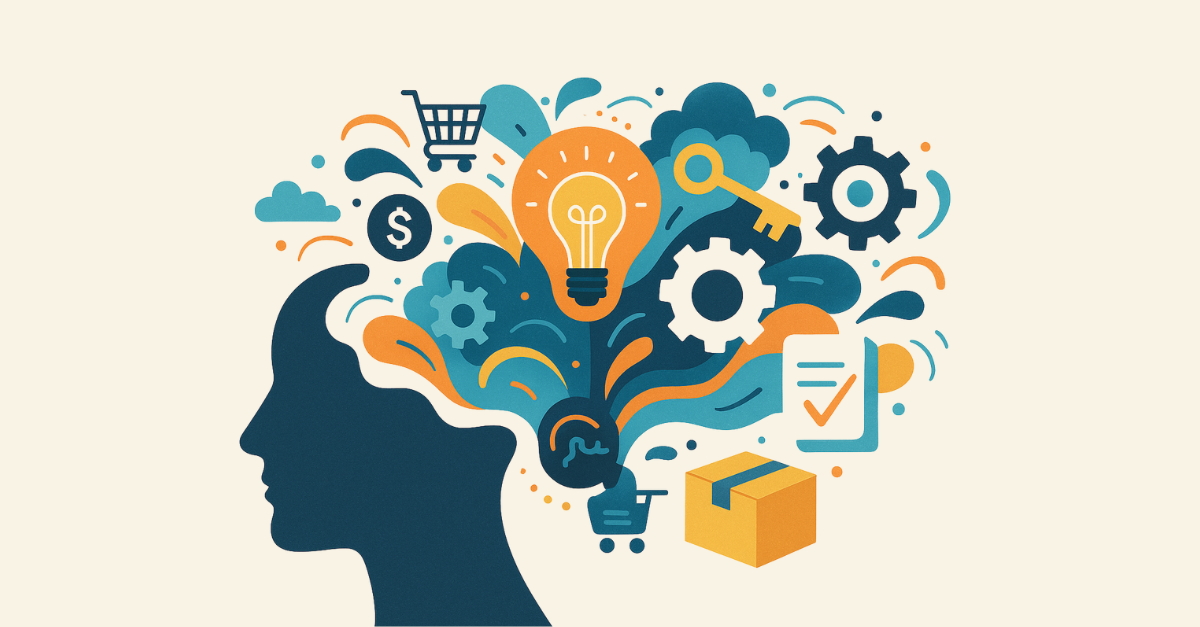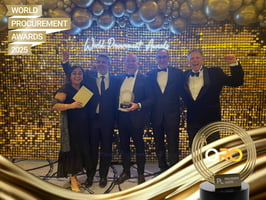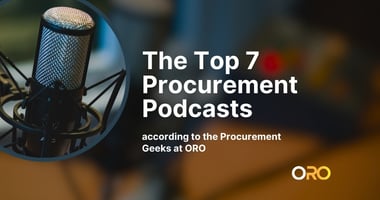What is Agentic Procurement Orchestration? A Key to Unlocking the Procurement Imagination.

Procurement stands at an inflection point. Across large enterprises, the function is under more pressure than ever—expected to deliver innovation, manage risk, and move faster amid global volatility. Yet most teams remain held back by disconnected systems, shrinking resources, and manual workflows that can’t keep pace with business change.
According to ORO Labs’ 2025 State of Enterprise Procurement Agility Report, nearly half of procurement leaders say pressure on their function is higher than usual, but only 30% report growing their teams. Meanwhile, 85% are now piloting or deploying AI to close the gap, even as trust and readiness lag behind. This combination of high expectations, small teams, and growing technological complexity has created the conditions for a new model to emerge—one that blends automation, intelligence, and coordination at scale: agentic procurement orchestration.
What is procurement orchestration?
Procurement orchestration is the connective tissue that coordinates people, systems, and processes across the enterprise. Rather than relying on fragmented point solutions and manual handoffs, orchestration provides a unified framework that integrates tools and data, enabling procurement to operate—and for business users to experience procurement—as a single, end-to-end workflow.
In the words of ORO Labs CEO Sudhir Bhojwani, “Procurement teams aren’t struggling because they lack tools. They’re struggling because their tools don’t work together.” When systems are fragmented and inflexible, even small process changes require escalation, delay, or workarounds. Orchestration solves that by creating a flexible infrastructure layer that connects workflows, breaks down silos, and allows teams to move at the speed of the business.
In practice, orchestration might look like this:
- a unified intake process that
- routes requests through policy-based approvals,
- integrates automatically with ERP and finance systems,
- triggers supplier onboarding or risk review where needed, and
- maintains real-time visibility at every step.
By connecting systems of record with systems of engagement, orchestration transforms procurement from a linear series of transactions into a dynamic, data-driven process.
At its best, orchestration does more than streamline operations—it enables agility. It ensures that when markets shift, sourcing plans can pivot just as quickly. In ORO Labs’ research, 80% of executives said their current tech environments were slowing them down, often because of rigid systems and siloed data. Orchestration addresses that friction by delivering a single adaptable backbone through which procurement can evolve continuously, not just episodically.
What are AI agents?
Agentic AI represents the next stage in this evolution. In Agentic AI and the Future of Procurement, we define AI agents as autonomous, goal-oriented systems capable of performing complex procurement tasks with limited human supervision. They go far beyond traditional automation or RPA by combining reasoning, learning, and adaptability.
Each agent operates like a digital team member: it can read data, analyze context, make informed decisions, and act—whether that means validating a purchase request, assessing supplier risk, or drafting a contract clause.
These agents have several key capabilities:
- Data ingestion and processing. pulling data from multiple sources, including ERP, SRM, and market intelligence platforms.
- AI-driven decision-making. Using predictive models to recommend or execute optimal actions.
- Goal-oriented orchestration. Sequencing dynamic tasks toward a defined objective.
- Feedback-driven learning. Refining future decisions through human input and environmental feedback.
- Integration. Connecting with existing enterprise platforms to act within real business processes
Unlike earlier generations of automation, agentic AI doesn’t just follow instructions—it interprets intent. It can plan multi-step actions, self-correct, and adapt to changing priorities, much as a human professional would. For procurement, that means intelligent automation that doesn’t just move faster but moves smarter.
Why orchestration is essential for getting the most out of agents
Deploying AI agents in isolation risks recreating the same fragmentation that plagues today’s procurement ecosystems. To be effective, agents need coordination, context, and governance—all of which orchestration provides.
Think of orchestration as the operating environment that allows multiple agents to collaborate seamlessly. In an agentic system, no single AI performs the entire procurement process. Instead, one agent might analyze supplier risk, another might draft a contract, and a third might process approvals. Orchestration ensures that each agent knows when to act, what data to use, and how to pass outcomes to the next agent in line.
In this sense, orchestration plays three crucial roles:
- Structure and alignment. It defines workflows and objectives so agents can work toward shared goals rather than acting independently.
- Governance and control. It ensures that human oversight, escalation paths, and compliance checks are built into every automated process.
- Connectivity and data flow. It links agents to the right systems and data sources, ensuring that actions are informed, traceable, and auditable.
Without orchestration, enterprises risk creating “agentic silos”—powerful but disconnected tools that lack the context or authority to drive business outcomes. With orchestration, those same agents become part of a cohesive, intelligent network capable of handling entire processes autonomously while keeping humans in the loop for judgment and strategy.
As ORO Labs’ research highlights, agility now depends less on the number of technologies organizations adopt and more on how well they integrate them. Future resilience requires procurement orchestration—the connective tissue that turns tool sprawl into coherent, flexible infrastructure.
What agentic procurement orchestration means for the future of procurement
To understand why agentic procurement orchestration matters, it helps to revisit procurement’s origins. Historically, procurement has always been about innovation. From the earliest industrial supply networks to modern global sourcing, procurement’s role has been to enable growth by finding new materials, partners, and capabilities that give organizations a competitive edge.
But over time, as enterprises scaled and regulatory complexity grew, procurement’s scope expanded. What began as a strategic driver of innovation became increasingly dominated by transactional work: purchase order management, compliance checks, risk documentation. In many organizations, these necessary but routine tasks consumed so much bandwidth that the function’s true mission—driving value and innovation—was obscured.
Agentic procurement orchestration offers a way to correct that imbalance. By automating the manual, repetitive elements of procurement through AI agents and connecting them via orchestration, the function can reclaim its strategic focus.
Consider a few practical examples from ORO Labs’ research and industry use cases:
- Supplier risk monitoring. Agentic systems can continuously scan thousands of data points—from financial reports to real-time news—to flag emerging supplier risks and even suggest alternative sourcing options before disruptions occur. This shifts procurement from reactive firefighting to proactive resilience.
- Autonomous sourcing and negotiation. Agents can analyze market data, solicit bids, and conduct negotiation rounds automatically, freeing teams to focus on supplier collaboration and long-term partnerships.
- Dynamic compliance and contracting. Through orchestration, AI can ensure every purchase request or contract flows through the right policy and approval path, maintaining governance without slowing down the business.
In each case, orchestration coordinates the agents, systems, and people involved—ensuring transparency, control, and continuous learning across the process.
The broader implication is that procurement teams can finally reallocate their most valuable resource—time. Instead of chasing approvals or reconciling data, they can invest in activities that create enterprise-wide value, such as sustainability initiatives, supplier innovation programs, or strategic sourcing aligned with growth objectives. As ORO Labs’ co-founder Lalitha Rajagopalan notes, the organizations that build for agility “will be best equipped to weather what comes next.”
In this way, agentic procurement orchestration doesn’t replace people—it amplifies human capability. It allows procurement professionals to act as orchestrators of strategy, guiding intelligent systems rather than managing manual tasks. It restores the creative, entrepreneurial spirit that once defined the field, while ensuring governance, speed, and resilience on a scale that was previously impossible.
The path forward
For most enterprises, adopting agentic procurement orchestration will be a journey rather than a switch. ORO Labs’ whitepaper outlines several stages of maturity: from piloting isolated agents to integrating them into orchestrated workflows to achieving fully autonomous, governed systems. And we have built a tool that lets you see where you are on your AI maturity journey. In speaking with customers and industry analysts, a common theme is that the best time to start your agentic AI journey is now: start small, demonstrate value, and scale.
The most significant barrier to scaling AI in procurement isn’t a lack of interest, but fragmented infrastructure. Success depends on building the right environment for AI to thrive: connected workflows, accessible data, and systems that teams can adapt without months of IT backlog.
In essence, the future isn’t just AI-powered—it’s AI-orchestrated. Agentic procurement orchestration represents a structural shift in how enterprises will operate. It turns procurement from a process manager into an innovation enabler, from reactive compliance to proactive intelligence.
As history shows, procurement has constantly evolved alongside technological change—from paper-based purchasing to ERP, from e-sourcing to autonomous sourcing using AI agents. Each wave has promised greater efficiency. But this time, the change is more profound: agentic orchestration doesn’t just make procurement faster; it makes it more intelligent, more connected, and more human.
The organizations that embrace this model will be the ones that rediscover procurement’s true mission—not as a cost center, but as a driver of enterprise growth and innovation.




